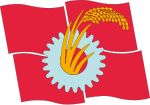Unified Socialist League
The Unified Socialist League (Japanese: 統一社会主義リーグ, romanized: Toitsu Shakaishugi Domei, abbreviated Toshado) was a pro-Soviet communist organization in Japan, founded on May 3, 1962. The Unified Socialist League was led by Kasuga Shojiro, formerly a leading figure in the Japanese Communist Party.[1] Makoto Omori was the general secretary of the organization.[2] The organization emerged from a split from the (a.k.a. the 'Socialist Renovation' group). The membership of the Unified Socialist League (numbering around 600) was dominated by students, and the organization had a student wing called the .[1]
The Unified Socialist League published a monthly journal, Kozo Kaikaku ('Structural Reform'). It had a circulation of around 2,200.[1] Kozo Kaikaku was published between May 1962 and December 1963. In May 1964 the Unified Socialist League launched a new publication, Heiwa to Shakaishugi.[3]
The Unified Socialist League repeatedly attacked the Communist Party of Japan, arguing that the party lacked internal democracy and that it was subservient to Chinese interests.[1] The Unified Socialist League did not put forth candidates in national elections.[4]
References[]
- ^ Jump up to: a b c d Scalapino, Robert A. The Japanese Communist Movement, 1920–1966. Berkeley: University of California Press, 1967. pp. 144-145
- ^ Nihon Shakai Shisō Kenkyūsho (Tokyo, Japan). Japan Interpreter. Tokyo: Center for Japanese Social and Political Studies], 1970. p. 93
- ^ Tōkyō Daigaku. Annals of the Institute of Social Science. Tokyo, Japan: The Institute, University of Tōkyō, 1966. p. 109
- ^ Staar, Richard Felix, Milorad M. Drachkovitch, and Lewis H. Gann. Yearbook on International Communist Affairs. Stanford, Calif: Hoover Institution Press, 1966. p. 341 (Yearbook on International Communist Affairs series)
- Communist parties in Japan
- Political parties established in 1962
- Defunct political parties in Japan
- 1962 establishments in Japan
- Communist party stubs
